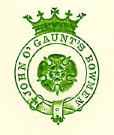The origin of the John O’Gaunt’s Bowmen is thought to go back beyond the recognised reformation date of 1788. Proof is difficult as many of Lancaster’s records were destroyed in disastrous fires in the 16th and 17th century. It was also known as a Society not a club.
It had an official shooting uniform in 1788 which consisted of dark green frock coat, with plain yellow buttons, with a bow and arrow embroidered on a black velvet collar, white kerseymere breeches and waistcoat and stockings, a black hat with one green and one black feather.
In 1820 the Society had two uniforms, one for shooting and the other Full Dress. For this they added to the above white silk lining to the coat, crimson military sash and black stock or neck cloth. The shooting dress was changed to Kendal green frock- coat with gilt buttons depicting three crossed arrows, white drill trousers, a green forage cap with the black and green feathers and a black neck cloth or stock.
At this time, it was customary to give a “bishop” or comparative gift upon election to the Society. Upon marriage a member was expected to give a minimum of twelve bottles of wine, but this was usually exceeded on a lavish scale.
During the 1850’s it’s annual shoot was held on the Fairfield in Lancaster often followed by a lavish ball. On this day the town had a half day holiday and a military band played at the event. The number of spectators often exceeded 3000. The trophies during the 1800’s were usually silver. The finest was a silver jug holding about a gallon, engraved with Society’s badge of a rose and crown surrounded by “John O’Gaunt’s Bowmen – Centenary Challenge Prize 1788-1888”. Other prizes were Champion Medal and Clasp dating from 1789, a large silver arrow dated 1788, small silver arrow 1820, a gilt arrow 1829. Best gold was often a solid gold keep sake. None of these items currently exist; they have been lost from sight after being placed in an antique shop in Lancaster and then being reclaimed by someone connected to the club in 1968/70.
The original Society badge was a Tudor Rose where the crossed arrows are positioned on the current badge. The change seems to have been made at about the turn of the Centenary.

Prior to the Second World War the Society consisted mainly of Lancaster and District society. The Ball lists read like a who’s who. Following the war, the makeup of the society changed to a more cross section of the population. Of course, the sport also changed.
Throughout its long history J.O.G has produced archers of a very high standard for both national and county events, amongst them Champions. J.O.G members were involved at the start of the G.N.A.S. Members have also been elected to the prestigious Royal Toxophilite Society throughout its long history.